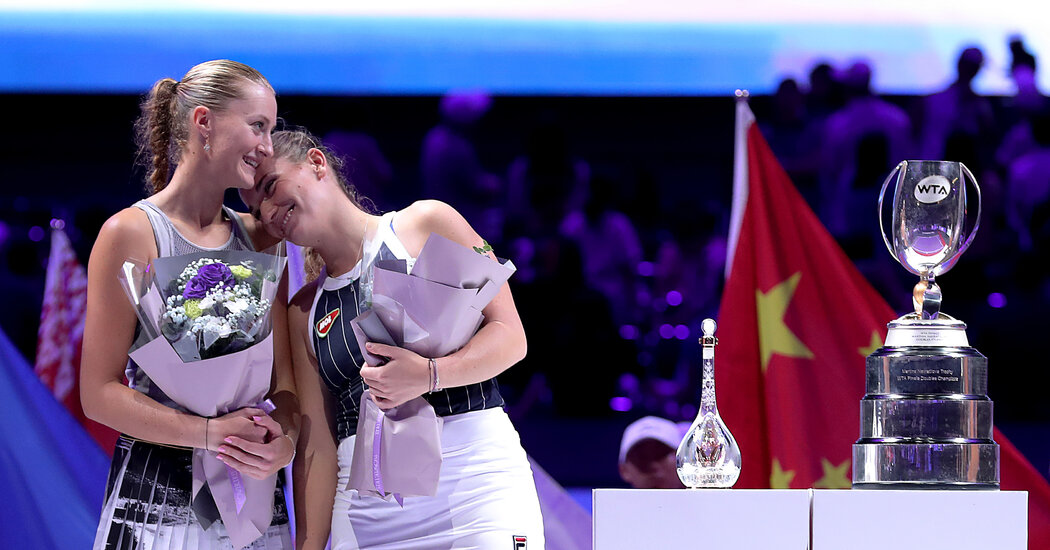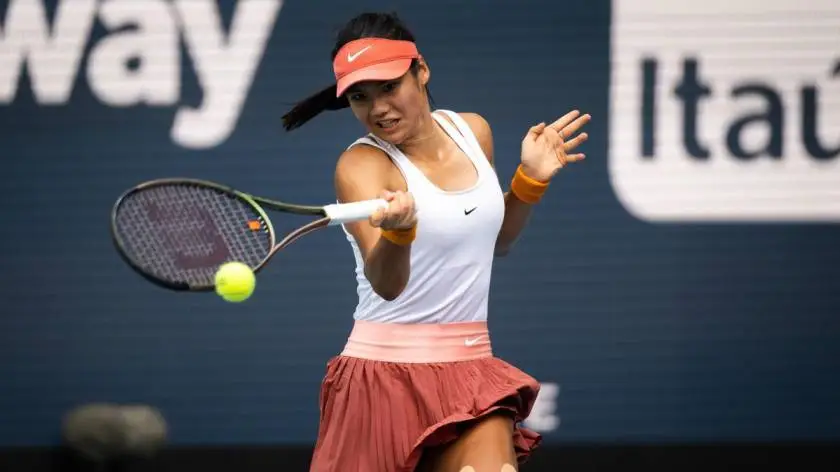
Canceled Tournaments in China Are a Big Blow to Women’s Tennis
In a season full of foiled plans and economic peril, the WTA Tour suffered its biggest blow on Thursday when it was forced to cancel its remaining tournaments in 2020 in China, including its lucrative tour championships: the WTA Finals in Shenzhen.
The cancellations, announced by the WTA, came two weeks after a Chinese government sports agency recommended that the country call off most international sporting events for the remainder of the year because of the coronavirus pandemic.
Steve Simon, the WTA’s chief executive, had expressed hope that China’s government and its tennis officials would allow the tournaments to proceed, just as it was allowing certain winter sports test events to go on ahead of the 2022 Winter Olympics in Beijing.
Negotiations proved unsuccessful, however, and the women’s tour will now have to cancel all seven events scheduled in October and November in China, which has rapidly become one the tour’s major markets and a key source of revenue.
“Obviously they’ve done a great job mitigating it,” Simon said of China and the coronavirus in an interview on Thursday. “The numbers are very much under control and if you look around the world and to areas where it’s really spiking and not being as well controlled I think the Chinese are doing everything they can to protect that environment. One of the best ways to protect it is to keep everything locked down.”
Latest Updates: Global Coronavirus Outbreak
- California and Texas are among the states setting new daily records.
- Landlords are jumping the gun as an eviction moratorium wanes.
- For workers who cobble together employment, the pandemic has exposed deep holes in the safety net.
The WTA Finals provided a record $14 million in prize money in its first year in Shenzhen in 2019 with backing from its primary sponsor Shiseido, a Japanese cosmetics company. In total, the WTA’s China swing in 2019 offered about $30 million in prize money.
“All the leagues and all the sporting events right now are struggling,” Simon said. “This has hurt everybody significantly. Whatever people have in reserves are going to get burned up, no question. But we are fortunate that we’re in a position that we can manage it. It’s not going to be easy, not easy for anybody, but we’ll get through it. We planned for the worst and so far we haven’t hit total worst. So we’ll look at this with the glass maybe not half full but a quarter full.”
The men’s tennis tour also will be hurt by the cancellation of the China Open in Beijing, the Chengdu Open, the Zhuhai Championships and the Rolex Shanghai Masters, a top-tier ATP event. Two golf events in Shanghai will be canceled: an L.P.G.A. tournament and the men’s HSBC Champions, a World Golf Championships event. The Shanghai Grand Prix, a Formula One race that was postponed in April, is now not expected to happen in 2020.
But the women’s tennis tour is the international sports organization that will be affected most deeply by China’s decision. The WTA depends on the finals, which bring together the season’s top eight singles players and top eight doubles teams, for a major chunk of its annual revenue. According to Simon, it has no cancellation insurance that would apply in a pandemic.
The WTA has a 10-year deal with Shenzhen, and the city is building a new 12,000-seat stadium to host the finals and other sporting events. Simon has said Shenzhen’s total investment in tennis infrastructure and the WTA Tour would likely amount to more than $1 billion.He said he did not expect the tour would rethink its focus on China. “We know there’s still a very strong commitment to us there,” he said. ”It’s just an unfortunate situation. We are disappointed in the decision but respect it.”
Though there have been plenty of shifts in the tennis calendar this year, with the French Open moving its starting date from May to September and Wimbledon being canceled, Simon said it was “very improbable” that the tour could move the 2020 finals to another country. He said the tour might add some events in the now-empty late season but that finding financing would be challenging. There is still a chance that the Asian tournaments in Seoul, South Korea, in early October and Tokyo in early November could be maintained, and Simon said they might be moved closer together to create a much smaller Asian swing.
The other six Chinese tournaments to be canceled by the WTA are the China Open in Beijing, the Wuhan Open, the Jiangxi Open in Nanchang, the Zhengzhou Open, the WTA Elite Trophy in Zhuhai and the Guanghzhou Open.
The China Open is a premier mandatory event, the highest category of tournament on the regular WTA Tour (the four Grand Slam events operate independently). Three of the four premier mandatory events have been canceled in 2020 with only the Mutua Madrid Open, rescheduled for September, still a possibility. For now, the WTA Tour is set to resume on Aug. 3 after a five-month hiatus with a clay-court event in Palermo, Italy, followed by tournaments in Prague and Lexington, Ky.
The Coronavirus Outbreak ›
Frequently Asked Questions
Updated July 23, 2020
-
What is school going to look like in September?
- It is unlikely that many schools will return to a normal schedule this fall, requiring the grind of online learning, makeshift child care and stunted workdays to continue. California’s two largest public school districts — Los Angeles and San Diego — said on July 13, that instruction will be remote-only in the fall, citing concerns that surging coronavirus infections in their areas pose too dire a risk for students and teachers. Together, the two districts enroll some 825,000 students. They are the largest in the country so far to abandon plans for even a partial physical return to classrooms when they reopen in August. For other districts, the solution won’t be an all-or-nothing approach. Many systems, including the nation’s largest, New York City, are devising hybrid plans that involve spending some days in classrooms and other days online. There’s no national policy on this yet, so check with your municipal school system regularly to see what is happening in your community.
-
Is the coronavirus airborne?
- The coronavirus can stay aloft for hours in tiny droplets in stagnant air, infecting people as they inhale, mounting scientific evidence suggests. This risk is highest in crowded indoor spaces with poor ventilation, and may help explain super-spreading events reported in meatpacking plants, churches and restaurants. It’s unclear how often the virus is spread via these tiny droplets, or aerosols, compared with larger droplets that are expelled when a sick person coughs or sneezes, or transmitted through contact with contaminated surfaces, said Linsey Marr, an aerosol expert at Virginia Tech. Aerosols are released even when a person without symptoms exhales, talks or sings, according to Dr. Marr and more than 200 other experts, who have outlined the evidence in an open letter to the World Health Organization.
-
What are the symptoms of coronavirus?
- Common symptoms include fever, a dry cough, fatigue and difficulty breathing or shortness of breath. Some of these symptoms overlap with those of the flu, making detection difficult, but runny noses and stuffy sinuses are less common. The C.D.C. has also added chills, muscle pain, sore throat, headache and a new loss of the sense of taste or smell as symptoms to look out for. Most people fall ill five to seven days after exposure, but symptoms may appear in as few as two days or as many as 14 days.
-
What’s the best material for a mask?
- Scientists around the country have tried to identify everyday materials that do a good job of filtering microscopic particles. In recent tests, HEPA furnace filters scored high, as did vacuum cleaner bags, fabric similar to flannel pajamas and those of 600-count pillowcases. Other materials tested included layered coffee filters and scarves and bandannas. These scored lower, but still captured a small percentage of particles.
-
Does asymptomatic transmission of Covid-19 happen?
- So far, the evidence seems to show it does. A widely cited paper published in April suggests that people are most infectious about two days before the onset of coronavirus symptoms and estimated that 44 percent of new infections were a result of transmission from people who were not yet showing symptoms. Recently, a top expert at the World Health Organization stated that transmission of the coronavirus by people who did not have symptoms was “very rare,” but she later walked back that statement.
Simon said he viewed those three events as a trial run for the rest of the tour as the virus continues to spread, especially in the United States. “I mean you have to expect there will be a positive case,” he said. “I think it’s how you manage it. You are going to have some, but you have to see if it’s something we’re able to control due to the uniqueness of how we have to operate.”
The WTA, which already has cut pay for its top employees during the pandemic and provided some financial relief to players, likely will need to dig into its reserves, which were estimated to be about half of the ATP’s before the pandemic. Under economic pressure, the WTA and ATP have had serious discussions about merging some commercial rights and much more tentative talks about a future merger.
The WTA Tour had total prize money of $179 million in 2019, including the four Grand Slam tournaments. That is up from $86 million in 2009. But this year will mark a big step backward with the tour shut down since March and with the cancellation of the Fed Cup team event and of Wimbledon, which did make some compensatory payouts this month to players who would have competed in the tournament. The United States Open, scheduled for Aug. 31 to Sept. 13 in New York, is still not certain to go ahead largely because of questions about quarantine requirements for players who would be heading back to Europe afterward.
Losing the WTA Finals this year also could cost the WTA its 2020 rights fee, which has not been disclosed but which Simon has said is significantly more than the approximately $14 million it received annually from the finals’ previous host city of Singapore.
“Women’s tennis can continue to be No. 1 in women’s sports. It just has to get through this pandemic,” said Chris Evert, the former No. 1 who spoke to the WTA players during a conference call earlier this month, urging them to embrace every opportunity to play in this challenging year. “Am I worried? No, but I know they will go through struggles for sure financially.”








